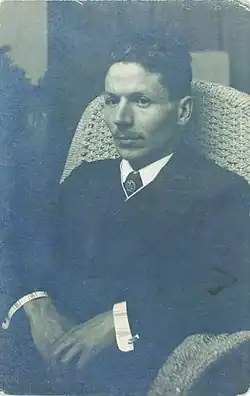Micka Pavlič
Micka Pavlič | |
|---|---|
| Born | Micka Pavlič March 30, 1821 |
| Died | September 12, 1891 |
| Occupation | Folk artist |
| Known for | Painted beehive panels |
Micka Pavlič, also called Marija Pavlič, Podnartovčeva Micka or Blažičeva Micka, Slovenian folk artist, March 30, 1821, Selca – September 12, 1891, Selca. She is best known for her vividly decorated beehive panels that are among the best created in 19th century Austrian empire.
Early life
She was born on March 30, 1821, in Selca in a poor family.[1] Her mother was a very small farmer and field labourer Elizabeta Gašperič, and her father was a very small farmer and folk artist Andrej Pavlič (1790–1873).[2][1][3] She had one sister, who letter become a very small farmer and field labourer.[2] At the young age her father started teaching her his art.[2]
Career
By her late teens she had surpassed her father and opened her own studio in Selca. Her father helped her.[4] She specialized in:
- Beehive panels: Wooden boards fitted to the entrances of beehives, decorated with scenes ranging from biblical narratives to allegorical and rural motifs.
- Glass paintings: Small-scale devotional images painted on glass panes for home altars.
- Wood carvings: “Bridke mantre” (devotional plaques) and other devotional figures for private and church use.
Her command of both pigment and chisel earned her a reputation.[5]
She painted beehive panels, images on glass, bitter mantras, chests. She specialized in the manufacture of beehive panels—elongated front panels for traditional Slovene beehives, using stencils punched with dozens of tiny holes.[6] Pigment in powdered form was applied by tapping a bag over the stencil, creating sharp, vibrant designs that have survived remarkably intact.[5]
Latter years

She taught her sister's grandson Peter Žmitek.[7] He went on to became a renown Slovenian painter.[7]After death of her parents she lived alone with two goats. She devoted herself only to art and painted until her death on September 12, 1891, in Selca.[2][8]
Style and technique
Micka’s figures are highly stylized. They are defined by clothing, posture, and activity rather than individualized features and rendered in a palette of reds (including Indian red), ochre, browns, blues, and greens. The use of stencils and powdered pigment ensured that her colors remained vivid even after decades out of direct sunlight.[3] Her workshop catalogue included at least 141 distinct motifs, 71 religious and 70 secular, ranging from biblical and devotional scenes to secular genre motifs such as the initiation rites of Mandan Native Americans[9], peasants quarreling over livestock, battle scenes and a Turk smoking a pipe.[3]
Legacy
Examples of Micka's beehive panels and glass paintings are preserved in the collections of the Slovenski etnografski muzej (Slovenian Ethnographic Museum) and the Loški muzej in Škofja Loka.[3] Her work remains a keystone of Slovenian folk-art studies, documented in Gorazd Makarovič’s 1962 monograph Panjske končnice ljudske slikarske delavnice iz Selc and in Boštjan Soklič’s 2015 article Indijanci Micke Pavlič (Native Americans of Micka Pavlič) in Loški razgledi.[9] Examples of her panels are held in public collections and continue to be studied as exemplars of 19th-century Carniolan folk painting.[3]
Gallery
-
.jpg) Duel between the Carinthian Woman and the Carniolan Woman (beehive panel)
Duel between the Carinthian Woman and the Carniolan Woman (beehive panel) -
.jpg) King David (beehive panel)
King David (beehive panel) -
.jpg) Battle scene (beehive panel)
Battle scene (beehive panel) -
 Hunter's funeral (beehive panel)
Hunter's funeral (beehive panel) -
.jpg) Jesus Calms the Storm on the Sea of Galilee (beehive panel)
Jesus Calms the Storm on the Sea of Galilee (beehive panel) -
.jpg) Hunting scene (beehive panel)
Hunting scene (beehive panel) -
.jpg) Beekeeper shoots at a bear (beehive panel)
Beekeeper shoots at a bear (beehive panel)
References
- ^ a b "Krstna knjiga / Taufbuch - 02124 | Selca | Nadškofijski arhiv Ljubljana | Slovenia | Matricula Online". data.matricula-online.eu. Retrieved 2025-07-07.
- ^ a b c d "O ljudskih umetnikih v Selski in Poljanski dolini" [About folk artists in the Selska and Poljanska valleys] (PDF) (in Slovenian). Archived from the original (PDF) on 2016-05-28.
- ^ a b c d e "Poslikane panjske končnice iz Selške delavnice v Selcah". Loški muzej Škofja Loka (in Slovenian). Retrieved 2025-07-07.
- ^ "Priloga". revija.ognjisce.si. Retrieved 2025-07-07.
- ^ a b "One moment, please..." (PDF). Archived from the original (PDF) on 2023-10-03. Retrieved 2025-07-31.
- ^ "Godcevski in plesni motivi na panjskih koncnicah" [Musical and dance motifs on the ends of the beehives] (PDF) (in Slovenian). Archived from the original (PDF) on 2018-04-19.
- ^ a b "Žmitek, Peter (1874–1935) - Slovenska biografija". www.slovenska-biografija.si. Retrieved 2025-07-21.
- ^ "Mrliška knjiga / Sterbebuch - 04159 | Selca | Nadškofijski arhiv Ljubljana | Slovenia | Matricula Online". data.matricula-online.eu. Retrieved 2025-07-21.
- ^ a b "dLib.si - Indijanci Micke Pavlič". www.dlib.si. Retrieved 2025-07-07.